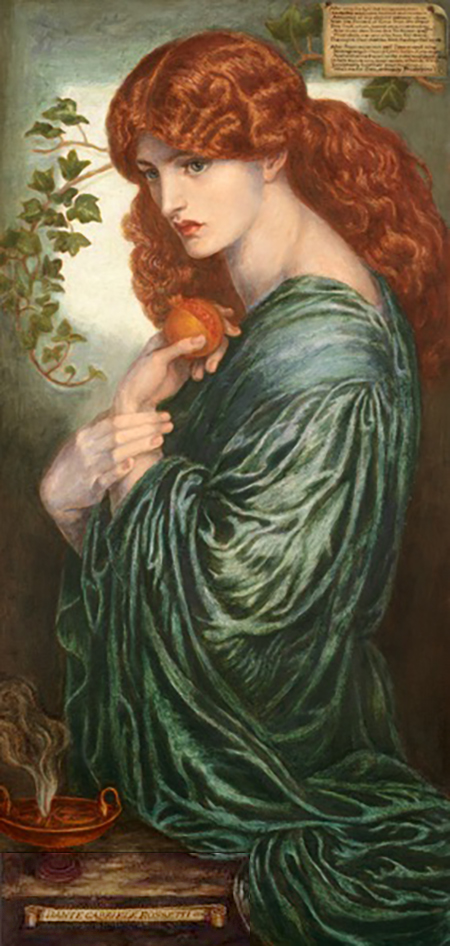
Continuing through September 8, 2019
The art in the big summer show “Victorian Radicals: From the Pre-Raphaelites to the Arts and Crafts Movement” will not be immediately familiar to many museum visitors. Who were the Pre-Raphaelite Brotherhood painters? And what, exactly, was the Arts & Crafts Movement? With everything borrowed from the Birmingham City Gallery in England, “Victorian Radicals” provides answers to both questions. The selections are timely and thought-provoking at a moment when artists’ impulse to create socially and politically relevant art have never been stronger.
How did young artists of the mid-19th century cope? A few years after Karl Marx published his “Communist Manifesto” in 1848, a group of art school graduates banded together to address social issues and restore vitality to British art which, according to them, had gone downhill steadily after the Medieval and Renaissance periods' culmination in the person of Raphael. They sought bright colors like Titian’s, dramatic subjects like Guercino’s, and tight realistic detail as in Raphael. Transferred to English topics like sheep-herding, Greek mythology, agricultural labor and humble workmanship (in contrast to the exploding Industrial Revolution), the group formed a brotherhood in 1849 (with women as ancillary supports), initially composed of Edward Burne-Jones, William Holman Hunt, John Everett Millais and Dante Gabriel Rossetti. With the backing of the top art critic of the day, John Ruskin, and the increasing patronage of the manufacturing barons and their wives of Birmingham, Liverpool and Manchester (gigantic factory cities), the Brotherhood gained recognition for their contemporary subject matter alluding to the Middle Ages and King Arthur’s Court. Their glistening painted surfaces merged background and foreground with equal and sensual detail. Their moral sincerity perfectly matched the twisted Victorian mixture of exploitation, aristocratic philanthropy, sexual hypocrisy and moral uplift.
It’s a pity we can’t recreate the atmosphere of moral (read Christian) approval and profoundly held convictions of the artists and their patrons, but the distance of over 150 years has shed an unbecoming light on their intentions, if not their artistic achievements. Modern art was beginning to happen in the meantime, and even though several of the Brotherhood worked in Paris and saw the rise of Impressionism first-hand, it was not for them. English art has always worked at a disadvantage to continental art for two reasons: poetry and nature. The accomplishments of British poets and landscape architects of that time overshadowed attempts by visual artists to not only equal literature and nature, but to avoid becoming hopelessly influenced by it.
That said, it’s worth having a look at some very important — and exquisitely executed — canvases, which fall into two categories: beautiful and awful. Ford Madox Brown’s “Work” (1855) is a study for the giant original at Manchester Art Gallery; it’s a composite of all social classes surrounding London sewer workers. At the corner, Brown (a Brotherhood mentor) placed conservative philosopher Thomas Carlyle as a “brain worker.” “The Death of Chatterton” (1855) by a second-generation Brother, Henry Wallis, displays the corpse of the 17-year-old poet Thomas Chatterton, the notorious literary forger who fooled a nation, dead of self-administered mercury to cure his syphilis. Again, the bigger, better original is in another museum, Tate Britain. Perhaps the most important Pre-Raphaelite painting of all, Millais’ “Death of Ophelia” (1852) is unfortunately not included in the exhibition. In its place is Rossetti’s signature “Proserpine” (1881), the model’s long red hair cascading down her exposed shoulder. Wallis’ “Stone Breaker” (1857) is the most convincingly serious picture, a dark, angry comment on virtual slave labor.
Among those that are hard to take is Arthur Hughes’s ludicrous “Long Engagement” (1854-59), the most laughable scene of sexual repression ever painted. A behatted minister of the cloth stares into the distance as his long-suffering fiancé pines for consummation. Beside them, their initials have been carved into the tree for so long (they cannot marry until he has a better job) that ivy has overgrown them. Susan Sontag described camp as “failed seriousness” and this qualifies. Equally hard to take though beautifully painted, is Millais’ “Blind Girl” (1854), playing a concertina no less, but oblivious to the double rainbow above her.
Arts and Crafts, the successor movement of virtuoso craftsmanship wedded to moral earnestness, is represented by impressive objects which fit into the strange contradiction of luxury carriage-trade household stuff and concerned overwrought empathy for the poor working class. This was the intellectual hallmark of the artisans surrounding founder William Morris, an Oxford poet and novelist who became an interior and wallpaper designer whose products are still in demand today. Silver, stained glass, jewelry, enamels and glass dot the survey with sparkling presence, complementing the shiny pictures, moody religious and secular subjects, and pervasive sense of irritating satisfaction driven by this Brotherhood’s collective conviction that art can make a difference.
